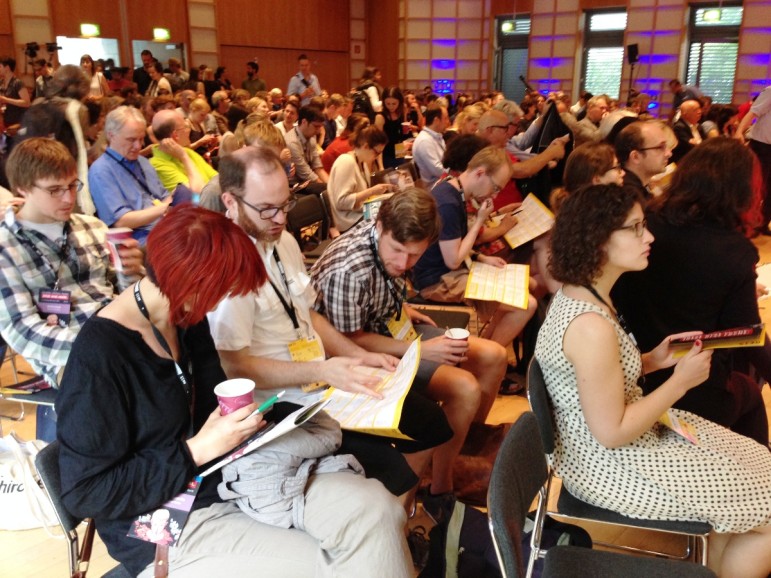Together with editor for the Data Projects team at the Guardian, Helena Bengtsson, I did a presentation about how to get started with datajournalism on the annual conference of Netzwerk Recherche 3rd of July in Hamburg. We made a tipsheet on twelve tips, which was spread on twitter.
After the presentation we have added three more tips to the list. We will continue to update and improve that tipsheet, is the goal.
Get started with datajournalism
If you have any suggestions for things to change or add, please send an email to me.
The Global Investigative Journalism Network published the list on their website and then tweeted about it:
Twelve Tips for Getting Started With Data Journalism by @nmulvad@HelenaBengtsson http://t.co/7V1IDGowq1pic.twitter.com/fouflX2ku7#nr15#ddj
— GIJN (@gijn) July 3, 2015
Here is the list right now with 15 tips:
Begin with small projects
There are many risks for errors in datajournalism. Begin with data and tools you can manage. Don’t start with the big project.
Learn tools of journalists
For journalists to understand the principles of calculating tools, you normally need a journalist as a teacher. It is often necessary to relate the concrete functions to journalistic tasks.
Check, and check and check for errors
There are nearly always error in data. Also when you get it from estimated authorities. You have the responsibility to get rid of the errors, before presenting it to the audience. Count totals – check if all is included or you miss something.
Make a public documentation of your data-work
Describe step by step what you have done, so others can check and do the same. It’s normally a good idea to share your data work with sources before publishing. For checking errors and agreeing on methods – and by doing that to avoid errors and critic of methods instead of discussion on content.
Use errors to get better internal sources
When you find errors in data, use them as a way to get a better relation to the people working with data at the authorities or institutions, that have delivered data.
Get the data
You can get the data just by asking, and they will email them to you. Else you can download them from the web, scrape them or get them using FOI-requests (Freedom Of Information). Develop and tune these methods, just as you do with interviews. All are journalistic methods.
Analyze the data – go for stories
Much datajournalism is too much data and too little journalism. We do this for stories. If there isn’t a story, don’t tell it. Find the stories and tell them one by one. Using interactive graphics is the same. Break it down to one clear story for each graphic or map. And tell it, so it is possible to get it. Don’t mix everything together in longreads, with too many angles.
What are really the story – using extremes
Think and rethink to get the stories in the data – and then check them against reality. The best way to describe stories is in the extremes. Use ranking as one of the best tools – to find errors and to explain the reality. That is journalism.
Datajournalism sometimes starts with the story – and sometimes with the data
Many journalists think you always should start with a story and then build data around it. But there is no reason for only doing datajournalism one way. Sometimes you get a good set of data, and the story is obvious. Other time you have to dive down in the data for seeing possible stories and then check if they are true.
Make data-cleaning yourself
When there are no data, structuring your own dataset might be your way to make the most incredible story. Looking down on data also gives you a feeling of content, stories and errors. Don’t always leave the hard work to researchers. Love your data.
Get rid of the numbers
Datajournalism is most often about humans. Get rid of the numbers and find the humans, who are the best examples of your data. Actually sometimes zero numbers are the best way to do a dataJOURNALISM story. You then might only include the data in a graphic. Or keep them for later. If you can’t find humans to explain your findings, they might be wrong. Or it might not be a story and then not journalism.
Work together and share
There is a great history of sharing by the people in the datajournalism-community. This is the only way we can keep up with the speed of the development of tools and methods. This way of sharing is more common here than in perhaps any other area in journalism.
Excel is 90 pct
Excel is normally the tool to use for importing, basic cleaning, basic sorting and other analysing and exporting data. Start learning Excel and keep using it. All the new tools are great, but don’t think you need all that and then forget the basic: Excel. We see far too many nice interactive graphics where the basic calculation is wrong. Sorry.
We want raw data
When you have the chance to negotiate with authorities for data, please be precise. As journalists we want the raw data from authorities – not aggregated. we want them fast and updated when new data is available. We want them in standard formats as xml, json, csv, etc. We want them comparable from country to country, state to state, municipality to municipality – whatever level – and not in different structures and content. We want a clear and short documentation of all fields in the data. We don’t need the authorities to make the data presentations. We’ll do that.
Develop your strengths – and work in teams
You can’t keep up with the development in all areas. Focus on your strengths and contribute with that in the teams you work with.




No comments yet.